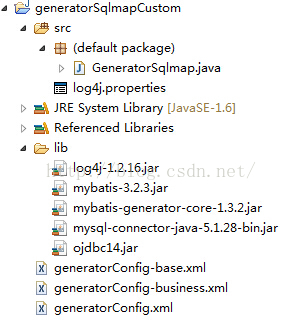您好,登录后才能下订单哦!
利用MyBatis如何创建一个逆向工程?相信很多没有经验的人对此束手无策,为此本文总结了问题出现的原因和解决方法,通过这篇文章希望你能解决这个问题。
1.什么是逆向工程
mybaits需要程序员自己编写sql语句,mybatis官方提供逆向工程 可以针对单表自动生成mybatis执行所需要的代码(mapper.java,mapper.xml、po..)
企业实际开发中,常用的逆向工程方式:
由于数据库的表生成java代码。
2.下载逆向工程
mybatis-generator-core-1.3.2-bundle.zip
3.使用方法(会用)
3.1运行逆向工程
官方文档中提供的运行逆向工程的几种方法
Running MyBatis Generator
MyBatis Generator (MBG) can be run in the following ways:
(1)From the command prompt with an XML configuration
(2)As an Ant task with an XML configuration
(3)As a Maven Plugin
(4)From another Java program with an XML configuration
(5)From another Java program with a Java based configuration
(6)还可以通过eclipse的插件生成代码
建议使用java程序方式(From another Java program with an XML configuration),不依赖开发工具。
下面创建一个生成逆向文件的工程,将自动生成的文件再拷贝到原工程中去(这么做是为了放止直接在源文件中生成会覆盖掉同名文件)
导入的jar包和工程结构截图如下:
如图

3.2生成代码配置文件
generatorConfig.xml:
<?xml version="1.0" encoding="UTF-8"?> <!DOCTYPE generatorConfiguration PUBLIC "-//mybatis.org//DTD MyBatis Generator Configuration 1.0//EN" "http://mybatis.org/dtd/mybatis-generator-config_1_0.dtd"> <generatorConfiguration> <context id="testTables" targetRuntime="MyBatis3"> <commentGenerator> <!-- 是否去除自动生成的注释 true:是 : false:否 --> <property name="suppressAllComments" value="true" /> </commentGenerator> <!--数据库连接的信息:驱动类、连接地址、用户名、密码 --> <jdbcConnection driverClass="com.mysql.jdbc.Driver" connectionURL="jdbc:mysql://localhost:3306/mybatis" userId="root" password="1234"> </jdbcConnection> <!-- <jdbcConnection driverClass="oracle.jdbc.OracleDriver" connectionURL="jdbc:oracle:thin:@127.0.0.1:1521:yycg" userId="yycg" password="yycg"> </jdbcConnection> --> <!-- 默认false,把JDBC DECIMAL 和 NUMERIC 类型解析为 Integer,为 true时把JDBC DECIMAL 和 NUMERIC 类型解析为java.math.BigDecimal --> <javaTypeResolver> <property name="forceBigDecimals" value="false" /> </javaTypeResolver> <!-- targetProject:生成PO类的位置 --> <javaModelGenerator targetPackage="cn.edu.hpu.ssm.po" targetProject=".\src"> <!-- enableSubPackages:是否让schema作为包的后缀 --> <property name="enableSubPackages" value="false" /> <!-- 从数据库返回的值被清理前后的空格 --> <property name="trimStrings" value="true" /> </javaModelGenerator> <!-- targetProject:mapper映射文件生成的位置 --> <sqlMapGenerator targetPackage="cn.edu.hpu.ssm.mapper" targetProject=".\src"> <!-- enableSubPackages:是否让schema作为包的后缀 --> <property name="enableSubPackages" value="false" /> </sqlMapGenerator> <!-- targetPackage:mapper接口生成的位置 --> <javaClientGenerator type="XMLMAPPER" targetPackage="cn.edu.hpu.ssm.mapper" targetProject=".\src"> <!-- enableSubPackages:是否让schema作为包的后缀 --> <property name="enableSubPackages" value="false" /> </javaClientGenerator> <!-- 指定数据库表 --> <table tableName="items"></table> <table tableName="orders"></table> <table tableName="orderdetail"></table> <table tableName="user"></table> <!-- <table schema="" tableName="sys_user"></table> <table schema="" tableName="sys_role"></table> <table schema="" tableName="sys_permission"></table> <table schema="" tableName="sys_user_role"></table> <table schema="" tableName="sys_role_permission"></table> --> <!-- 有些表的字段需要指定java类型 <table schema="" tableName=""> <columnOverride column="" javaType="" /> </table> --> </context> </generatorConfiguration>
3.3执行生成程序
GeneratorSqlmap.java:
import java.io.File;
import java.util.ArrayList;
import java.util.List;
import org.mybatis.generator.api.MyBatisGenerator;
import org.mybatis.generator.config.Configuration;
import org.mybatis.generator.config.xml.ConfigurationParser;
import org.mybatis.generator.internal.DefaultShellCallback;
public class GeneratorSqlmap {
public void generator() throws Exception{
List<String> warnings = new ArrayList<String>();
boolean overwrite = true;
//加载配置文件
File configFile = new File("generatorConfig.xml");
ConfigurationParser cp = new ConfigurationParser(warnings);
Configuration config = cp.parseConfiguration(configFile);
DefaultShellCallback callback = new DefaultShellCallback(overwrite);
MyBatisGenerator myBatisGenerator = new MyBatisGenerator(config,
callback, warnings);
myBatisGenerator.generate(null);
}
public static void main(String[] args) throws Exception {
try {
GeneratorSqlmap generatorSqlmap = new GeneratorSqlmap();
generatorSqlmap.generator();
} catch (Exception e) {
e.printStackTrace();
}
}
} 生成后的代码:
如图

3.4使用生成的代码
需要将生成工程中所生成的代码拷贝到自己的工程中。我们这里吧ItemsMapper.java和ItemsMapper.xml、Items、ItemsExample类拷入我们的原工程。
测试ItemsMapper中的方法
package cn.edu.hpu.ssm.test;
import static org.junit.Assert.fail;
import java.util.Date;
import java.util.List;
import org.junit.Before;
import org.junit.Test;
import org.springframework.context.ApplicationContext;
import org.springframework.context.support.ClassPathXmlApplicationContext;
import cn.edu.hpu.ssm.mapper.ItemsMapper;
import cn.edu.hpu.ssm.po.Items;
import cn.edu.hpu.ssm.po.ItemsExample;
public class ItemsMapperTest {
private ApplicationContext applicationContext;
private ItemsMapper itemsMapper;
//注解Before是在执行本类所有测试方法之前先调用这个方法
@Before
public void setup() throws Exception{
applicationContext=new ClassPathXmlApplicationContext("classpath:spring/applicationContext.xml");
itemsMapper=(ItemsMapper)applicationContext.getBean("itemsMapper");
}
//根据主键删除
@Test
public void testDeleteByPrimaryKey() {
fail("Not yet implemented");
}
//插入
@Test
public void testInsert() {
Items items=new Items();
items.setName("iPhone-5S");
items.setPrice(3999f);
items.setDetail("正品行货");
items.setPic("sdasd.jpg");
items.setCreatetime(new Date());
itemsMapper.insert(items);
}
//自定义条件来查询
@Test
public void testSelectByExample() {
ItemsExample itemsExample=new ItemsExample();
//通过Criteria构造查询条件
ItemsExample.Criteria criteria=itemsExample.createCriteria();
criteria.andNameEqualTo("电视机");
//可能返回多条记录
List<Items> list=itemsMapper.selectByExample(itemsExample);
for (int i = 0; i < list.size(); i++) {
Items it=list.get(i);
System.out.println(it.getId()+":"+it.getName());
}
}
//根据主键来查询
@Test
public void testSelectByPrimaryKey() {
Items items=itemsMapper.selectByPrimaryKey(1);
System.out.println(items.getName());
}
//更新数据
@Test
public void testUpdateByPrimaryKey() {
//对所有字段进行更新,需要先查询出来再更新
Items items = itemsMapper.selectByPrimaryKey(1);
items.setName("iPhone");
itemsMapper.updateByPrimaryKey(items);
//如果传入字段不空为才更新,在批量更新中使用此方法,不需要先查询再更新
//itemsMapper.updateByPrimaryKeySelective(record);
}
} 看完上述内容,你们掌握利用MyBatis如何创建一个逆向工程的方法了吗?如果还想学到更多技能或想了解更多相关内容,欢迎关注亿速云行业资讯频道,感谢各位的阅读!
免责声明:本站发布的内容(图片、视频和文字)以原创、转载和分享为主,文章观点不代表本网站立场,如果涉及侵权请联系站长邮箱:is@yisu.com进行举报,并提供相关证据,一经查实,将立刻删除涉嫌侵权内容。